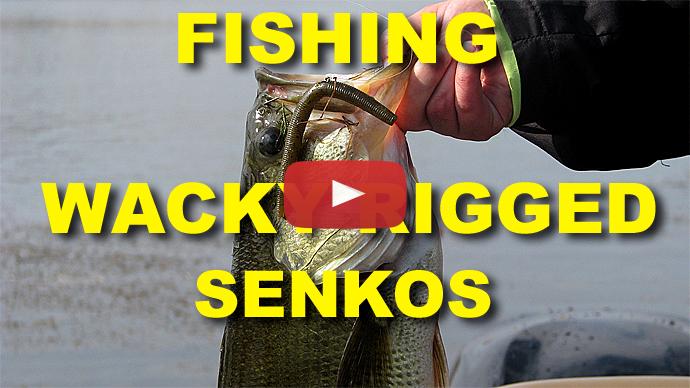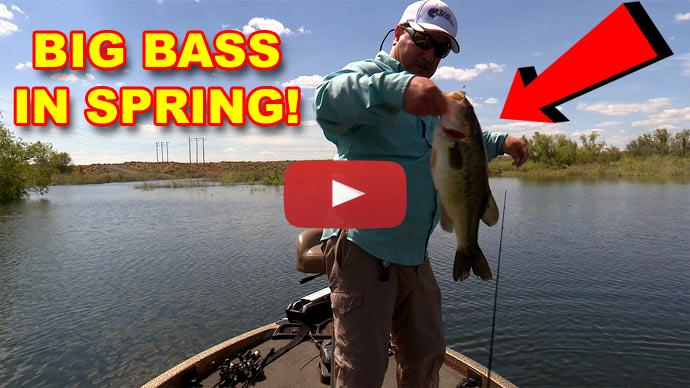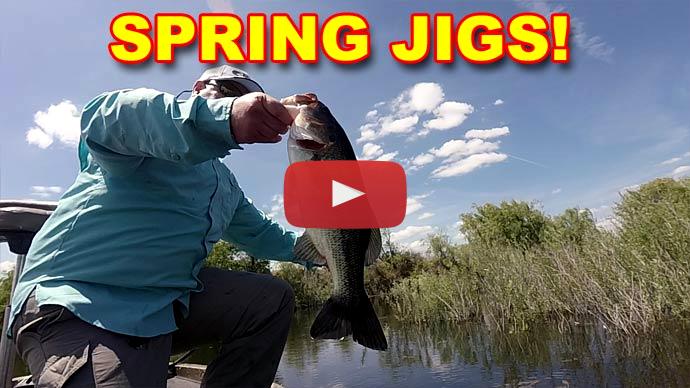Keri: There we go. It came out and got it that time.
Glenn: Nice.
Keri: Got him that time, little sucker. I saw him, he came darting out from that bush and said, "Hey, I want to play with the Senko." I should say stick bait, it's a V&M, I believe. He is a cute little guy. Come-hither, come-hither. I saw you, you darted right out from that bush and said, "I'll eat that." And that's what you did. You ate that. All right, little guy, go play. Have fun.
Glenn: Hey, folks, Glenn May here with BassResource.com. And I want to talk to you about spring fishing, particularly what baits to use throughout the entire spring, not just one part of the spring, but what baits work throughout the entire spring. And I know that can be a daunting task because it seems to change every day. There are so many selections and so many baits you can use. And your friends are using one kind of bait and you talk to somebody else, they're using something else. And then someone on YouTube tells you to use something else.
So what I've done is I've narrowed it down to three main baits that I use throughout the whole spring that could be productive everywhere you go, whether it's early spring or post-spawn, you know, anything in between, as well as the different colors that you should use depending on the water clarity. I'm going to get into that.
So, let's get into the top three baits that I like to use, starting with the jig. The jig is kind of a universal lure. I can use it throughout the whole season, but I like the jig during the spring because you can fish it all the way deep, you can fish it completely shallow, and you can fish it at different speeds. Plus, it's available in different head configurations, different sizes, and different colors.
Okay, cool. It's universal. However, that actually adds confusion, again, because there's of a lot of choices, right? So I narrowed it down. Here it is. In the early spring, when the fish are deep, then that's when I'm targeting things such as drop-offs, and steep points, steep banks, creek channels, sunken humps, in water that's deeper than 20 feet deep that are generally positioned in the entrances of those bays and coves where the fish are going to end up spawning. Now that's where the fish are going to stop and stack up and get ready to stage before they move shallow. So those are the places I'm going to target.
And I'll target it with a jig that's, you know, 1/2-ounce to 3/4-ounce jig, football head jig specifically. That deep, typically, there isn't any weeds to get wrapped around the head of the jig, so a football head jig is really good. And I don't really care about having a slow fall. I want to get it on the bottom and maintain contact with the bottom, hence the heavier jig.
What I'm doing here is dragging it slowly on the bottom, just very, very, just a slow drag. And what happens is that the football head jig just kind of wobbles back-and-forth just like this. And so it looks like a little crawdad crawling on the bottom, okay? A little protein snack for the fish that are getting ready to eat up for the spawn. I give it pauses in between, and then slowly crawl it again. Just a steady... That's about it.
As the water warms up and the fish move up shallower, then I'll move to a 3/8-ounce jig. Here I'm using an Arkie style head or a weedless jig, you know, a weed jig which is a cone-shaped jig. And I'll throw that into all available cover that I can find. I like to target anything you can see, so it could be laydowns, that could be rocks, scattered rocks, chunk rocks, could be stumps, even docks are really good. If you have an Arkie Jig on, then you can skip a jig up underneath the dock really well, all those areas where the fish are going to be, just getting ready for the spawn.
So, they'll be either right on the drops next to the flats or on the flats in that cover, and especially if a front's come through, which often happens in the spring, that's when the jig really shines because I can flip and pitch it right into that cover. Or if you get a lot of rain and the water levels rise and it floods some of the shorelines shrubs, and bushes, and timber, man, a jig is a really good way to pull them out of that cover. So that's when I start flipping and pitching.
For the spawn, I'll take that jig and I like to swim it over the top of the bed. Sometimes that gets a strike just by a reaction strike, bring it over the top of the bed, or I'll drag it over and I like to hop it through the bed. You got to be real careful when you do that. If there are eggs on the bed, I prefer not to do that because I don't want to disturb the nest and I don't want to damage any of the eggs. But if they haven't laid eggs yet, then bring it across the bed like that. Sometimes, you know, crawdads is a natural predator, the bass will strike it.
I only ask that if you do catch fish off beds that you release them right away so they can finish the spawn and do their thing so they can have a productive spawn.
Following the spawn, post-spawn, jig again, same thing in those flats where they were at before, any available cover, any of the drops adjacent to flats. You find any kind of flooded bushes, trees, weeds, things like that, it's a great place to throw a jig.
As for colors, I typically stay to the browns and the green hues. I really don't change too much other than that unless I get real muddy water and then I'll use a black and chartreuse jig. But typically, it's brown color or a green pumpkin-type colored jig, that's what I use the most.
My gear tends to change a little bit. When I'm fishing deeper in the early part of the spring, here I'm using the 7-foot medium-heavy rod, fast action. And I'm using AbrazX, Seaguar Fluorocarbon AbrazX line, 20-pound test. I do that because most of the time I'm pulling it over rocks, and fluorocarbon does a better job as far as abrasion resistance than braid. So I like to use AbrazX, it's geared for this kind of stuff. It's a perfect combination. And I'll use it on a reel that's like a 7:3:1 reel. The gear ratio doesn't really matter because I'm fishing it really slow. Now, as the spring progresses and I'm now fishing it shallow, I'm flipping and pitching, now I'm using a heavier stouter rod and gear. I'm using the 7'2" to 7'4" heavy power rod with a fast action tip. I'm spooling it up with 50 pound Seaguar Smackdown Braid with a 7:3:1 gear ratio. Sometimes I'll knock it down to a 6:8 or a 6:6 gear ratio if I'm really going into heavy cover because I want to wrench those fish out, so I want a lower gear ratio. But I'm doing a lot of flipping and pitching in all kinds of cover. So that's when I'm bringing out that heavy gear and the heavy braid. And that's about it. That's the perfect setup. Those are jigs.
Let's move on to the next bait, and that is a lipless crankbait. I love fishing lipless crankbaits in the spring. Something about them, that tight wiggle and that rattling action, the fish just key on during this time of the year, so it's an excellent time to use it. But also, the fish are on the move here. They're moving from shallow to deep or deep to shallow water, so you got to have a search bait handy to be able to find those fish, and a rattling lipless crankbait, that's the ticket.
Now, what I do early in the season is I'm throwing a heavier one. I'm throwing a 3/4-ounce rattling crankbait, and I like to get that down deep in the same areas where I was targeting the jig, and I want to pull it along and keep it towards the bottom. So instead of holding the rod up and cranking it like you normally do a crankbait, here, I'm holding it to the side and I do a sweeping action. And I pause, and I reel up, and I sweep again. Okay? That keeps the bait down on the bottom, but also, when you pause it, it flutters down. It's got this wiggle action as it falls and that often elicits a strike. So it's a great way to fish those deep water structure areas early in the season.
As the season progresses, now I like to take a 1/2-ounce bait, move up a little bit lighter, and I'm paralleling weed lines, I'm paralleling creek channels, I'm paralleling the shoreline. That works really well as well as covering the flats. Those fish get up on the flats getting closer to the spawn and I just like to cover flats with this bait, especially over weedy flats that may have an occasional stump or a rock in the middle of it, a rockpile, or a laydown.
During the spawn, I'll bring it over the tops of beds, and sometimes you can get a reaction strike on that, especially with smallmouth. If you bring it right over the top of a smallmouth bed, a lot of times they'll strike it right away out of reaction.
Then in the post-spawn, again, cover those flats, lots of fan-casting just like you did during the pre-spawn, and you can have yourself a heyday with these. These fish start to get really aggressive and want to feed up after recovering after the spawn. So it can be a really good bait to throw.
As for colors, typically, well, if I were to pick one color for the entire spring, it'd be red. You know, a red lipless crankbait, man, it's hard to beat. I don't know what it is, but these fish love red lipless crankbaits. So if I was going to pick one color, this is going to be it. However, I do change it up based upon water clarity. Typically, if the water is really clear, then I like to go with natural color baits, so here I'm using like the crawdad color, or bream, you know, bluegill bream kind of pattern, or perch, something like that, but natural color baits is what I want to use when the water is clear. If there's a little bit of stain to it, then I'll go with a gold color bait like that, okay? That works really well if you've got...the water's a little bit of color to it, less than 3 feet visibility or so, then that works really well. Up to 8 feet visibility, actually, 3 to 8, I'm meant to say 3 to 8. And then when the water is really muddy, say, for example, you've had a lot of rains come through and that water dirties up, then I throw some chartreuse in it. So baits like this work really well when you've got that chocolate milk kind of color. That's what I throw.
As for the gear, I'm using the same gear throughout the entire season really. I'm using a crankbait rod. So it's a 7-foot, a 7'2", yeah, 7'2" moderate-power rod and I have that paired up with 12-pound InvizX Fluorocarbon Line. Usually, when I'm fishing real shallow, I've got the InvizX Fluorocarbon Line, and when I'm fishing really deep I'll use Tatsu. Typically, because the Tatsu line, it's more limber, I can cast further, and it allows me to get that bait way out there and get it down deeper. But you can just use InvizX if you want to cast really well, just 12-pound, works fine. If you're fishing around a lot of heavy cover, with a lot of stumps, and rocks, and things like that, then I might bump that up and maybe use 17-pound, 15 to 17-pound line. But typically, a 12-pound works really well. And the reel is a faster gear ratio, 7:9:1 gear ratio. So, those are my lipless crankbaits.
Now, the next bait that I like to use is a Senko, you know, a soft plastic stick bait. That is really good in the spring, especially when the fish are in a neutral to negative feeding mode, that's when this bait really shines.
Early in the season, I'm fishing, again, those same spots, those deep points, those rock bluffs, those drop-offs, those steep banks, creek channels, humps, things like that that are near the entrances of those bays. And here, I'm using light gear. I want to put it on a split shot rig. You know, I've got 2 feet of line behind it because what I want is the action of that bait falling. So I give it a lot of extra line there, 2 feet, sometimes longer. I don't want that weight to be pulling down on the bait here. I want it to fall naturally. So I just use a small lift and drop action. What I mean by small, I'm not lifting it up 6 feet. I'm lifting it up 2 or 3 feet and dropping again and just letting it flutter down on its own. I'm using a medium-powered, 7-foot spinning rod with 6-pound Tatsu Line, fluorocarbon line, real light stuff.
By the way, a quick little tip, you can also throw this on a drop shot rig. Okay? A Senko, a little 3-inch Senko on a drop shot rig can be really deadly if the fish really are reluctant to bite. Say, a big front came through, works really well.
Now, as the temperatures warm up and the fish start to move shallow, then I'll change it all up. Now I'm throwing a 4 to 5-inch Senko with a 2/0, Extra Wide Gap Gamakatsu Hook, thin wire hook. And I'm throwing it around every kind of visible cover I can, right? You want to throw it at those bushes, and at those laydowns, the stumps, the rocks, and the edges, and drops of flats, skip it up under docks. This can be really productive if the fish are really buried up in the weeds. You can fish right along the edges of those and entice them out. Nice, subtle.
It's a weightless rig. I'm not putting any weights on it, so it just has this slow, enticing, horizontal fall to it, and that gets a lot of reluctant bass to bite. So it can be a real killer technique.
During the spawn, again, I like to drift it up over the top of those beds and just let it slowly settle right down on the bed, and then lift it back up. A lot of times you do that multiple repeated casts, the bass are going to go after and nail it. They're going to get tired of that thing bugging them. And then in the post-spawn, this can be really productive. Again, when they get up underneath those docks, or they get up against some of that cover or those wide-open flats, you just drift it across those flats.
As for colors, I tend to use green pumpkin all the time. If I get to use one color of a Senko, it would be green pumpkin. The only time really I change that color is if the water is really muddied up and dirty, then I'll go to a Junebug color. Or if the water is super clear, then I might go to a smoke color with some pepper flake in it. But 80%, 85% of the time it's green pumpkin. It works so well that I don't really need to... I know they make hundreds of colors, over 100 colors in this bait, but you don't need to go too hogwild with colors.
And as far as gearing, now I told you about the spinning outfit, you know, when I'm fishing deep, but when I'm fishing up in those shallow areas, now I'm using a 6'10" medium-power rod, fast action tip with...I pair with that, I've got 15-pound InvizX Fluorocarbon Line.
And I got that for a couple of reasons, a little bit more limber rod because it's a lighter lure, it's easier to cast with a limber rod. Plus, I've got that thin wire hook on it, so I don't need a lot of backbone to set the hook. Actually, I want a little bit of give so the fish doesn't rip that hook out of his mouth.
I'm using InvizX Fluorocarbon Line, again, because that line, it falls about the same rate as the bait. So it doesn't impede the action of the bait and it's less visible to the fish. It's a slow presentation. You don't want to give them a whole lot of time to examine things, but if they do, are examining it, I really don't want them to focus on that line. So I'm not using braid, I'm using this InvizX. And that's it. That's it for Senkos. That's a great bait to use throughout all of spring.
Okay. So those are my top three baits that I like to use throughout the whole spring. I hope that helps. For more tips and tricks like this, visit BassResource.com.



